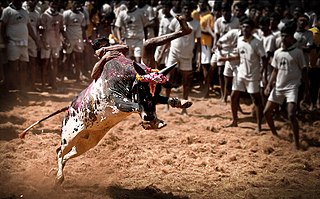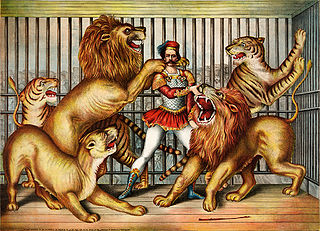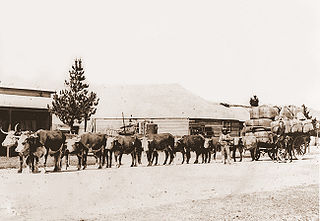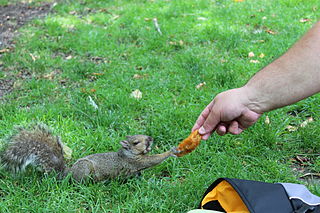
A shield is a piece of personal armour held in the hand, which may or may not be strapped to the wrist or forearm. Shields are used to intercept specific attacks, whether from close-ranged weaponry or projectiles such as arrows, by means of active blocks, as well as to provide passive protection by closing one or more lines of engagement during combat.

The unicorn is a legendary creature that has been described since antiquity as a beast with a single large, pointed, spiraling horn projecting from its forehead. The unicorn was depicted in ancient seals of the Indus Valley Civilization and was mentioned by the ancient Greeks in accounts of natural history by various writers, including Ctesias, Strabo, Pliny the Younger, Aelian and Cosmas Indicopleustes. The Bible also describes an animal, the re'em, which some versions translate as unicorn.

An antelope is a member of a number of even-toed ungulate species indigenous to various regions in Africa and Eurasia.

In the Old Norse written corpus, berserkers were those who were said to have fought in a trance-like fury, a characteristic which later gave rise to the modern English word berserk. Berserkers are attested to in numerous Old Norse sources.

Jallikattu, also known as eru thazhuvuthal and manju virattu, is a traditional spectacle in which a bull, such as the Pulikulam or Kangayam breeds, is released into a crowd of people, and multiple human participants attempt to grab the large hump on the bull's back with both arms and hang on to it while the bull attempts to escape. Participants hold the hump for as long as possible, attempting to bring the bull to a stop. In some cases, participants must ride long enough to remove flags on the bull's horns.

The grey-winged trumpeter is a member of a small family of birds, the Psophiidae. It is found in the northern Amazon rainforest and Guiana Shield in tropical South America. Unlike all other trumpeters, the rump and back are grey in the grey-winged trumpeter.

Lion taming is the taming and training of lions, either for protection or for use in entertainment, such as the circus. The term often applies to the taming and display of lions and other big cats such as tigers, leopards, jaguars, black panthers, cheetahs, and cougars. People often use lion taming as a metaphor for any dangerous activity. Lion taming occurs in zoos across the world to enable the keepers to carry out medical procedures and feedings.

The Russian domesticated red fox is a form of the wild red fox which has been domesticated to an extent, under laboratory conditions. They are the result of an experiment which was designed to demonstrate the power of selective breeding to transform species, as described by Charles Darwin in On the Origin of Species. The experiment was purposely designed to replicate the process that had produced dogs from wolves, by recording the changes in foxes, when in each generation only the most tame foxes were allowed to breed. In short order, the descendant foxes became tamer and more dog-like in their behavior.

The domestication of animals is the mutual relationship between animals and the humans who have influence on their care and reproduction. Charles Darwin recognized a small number of traits that made domesticated species different from their wild ancestors. He was also the first to recognize the difference between conscious selective breeding in which humans directly select for desirable traits, and unconscious selection where traits evolve as a by-product of natural selection or from selection on other traits. There is a genetic difference between domestic and wild populations. There is also a genetic difference between the domestication traits that researchers believe to have been essential at the early stages of domestication, and the improvement traits that have appeared since the split between wild and domestic populations. Domestication traits are generally fixed within all domesticates, and were selected during the initial episode of domestication of that animal or plant, whereas improvement traits are present only in a proportion of domesticates, though they may be fixed in individual breeds or regional populations.

A working animal or draughtanimal is an animal, usually domesticated, that is kept by humans and trained to perform tasks. They may be pets or close to pets, such as guide dogs or other assistance dogs, or they may be animals trained to provide tractive force, such as draft horses or logging elephants. The latter types of animals are called draft animals. Most working animals are either service animals or draft animals. They may also be used for milking or herding, jobs that require human training to encourage the animal to cooperate. Some, at the end of their working lives, may also be used for meat or other products such as leather.

Haughton is a township forming the eastern portion of Denton, Tameside in Greater Manchester. The township probably dates from the Anglo-Saxon times, and was first recorded as Halcton or Halghton in the thirteenth century. In Saxon, Haughton means 'settlement' (ton) on 'low-lying land' (Haugh), and probably refers to the ancient township's location in the Tame Valley.
Dmitry Konstantinovich Belyayev was a Russian geneticist and academician who served as director of the Institute of Cytology and Genetics (IC&G) of the USSR Academy of Sciences, Novosibirsk, from 1959 to 1985. His decades-long effort to breed domesticated foxes was described by The New York Times as “arguably the most extraordinary breeding experiment ever conducted.” A 2010 article in Scientific American stated that Belyayev “may be the man most responsible for our understanding of the process by which wolves were domesticated into our canine companions.”

Tame Yourself was an album released by Rhino Records on April 30, 1991 to benefit PETA.
Self-domestication is the process of adaptation of wild animals to life with humans, without direct human selective breeding of the animals. The term has also been used to refer to biological processes in the evolution of hominids, particularly humans and bonobos, toward collaborative ("tamer") behavior and control of reproduction.

The Faroese goose is probably the oldest form of tame goose in Europe and possibly the direct descendants of the tame geese that the Landnám folk brought from Scandinavia and the British Isles.

A tame animal is an animal that is relatively tolerant of human presence. Tameness may arise naturally or due to the deliberate, human-directed process of training an animal against its initially wild or natural instincts to avoid or attack humans. The tameability of an animal is the level of ease it takes humans to train the animal, and varies among individual animals, breeds, or species.

A Taming is a shield traditionally used by the Moro of the Philippines. It is made of tightly woven rattan. Its origin is uncertain: various scholars suggest it comes from Maranaos, Chinese, Moluccan, or Spanish. In Indonesian language, Tameng is a general term for shield.

The Lyin' Mouse is a 1937 Merrie Melodies cartoon directed by Friz Freleng.

Ark: Survival Evolved is an action-adventure survival video game developed by Studio Wildcard, in collaboration with Instinct Games, Efecto Studios, and Virtual Basement. It was released in August 2017 for PlayStation 4, Xbox One, Microsoft Windows, OS X and Linux, with versions for Android, iOS, and Nintendo Switch in 2018. In the game, players must survive being stranded on an island filled with roaming dinosaurs and other prehistoric animals, natural hazards, and potentially hostile human players.

Far Cry Primal is a first-person shooter video game developed by Ubisoft Montreal and published by Ubisoft. It was released worldwide for PlayStation 4 and Xbox One on February 23, 2016, and for Microsoft Windows on March 1, 2016. The game is a spin-off of the main Far Cry series. It is the first Far Cry game set in pre-modern times. It revolves around the story of Takkar, who starts off as an unarmed hunter and rises to become the leader of a tribe.

















